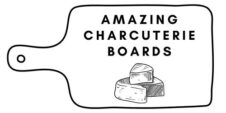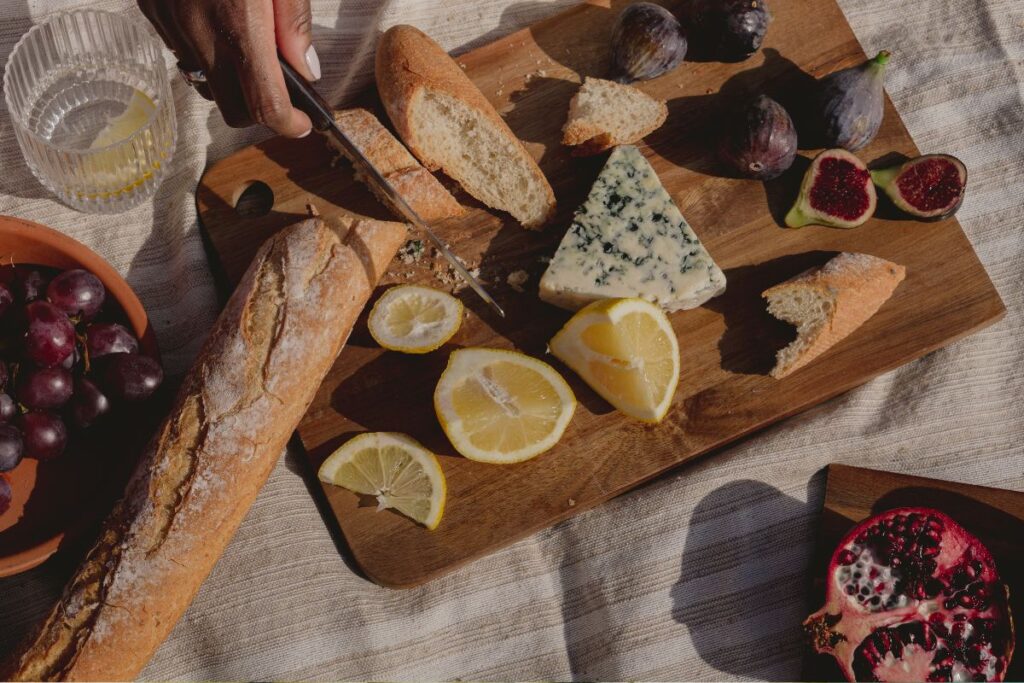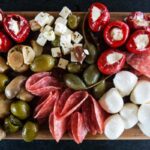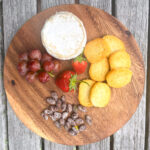Whether you are making your own charcuterie board or looking for the perfect charcuterie board for your next event, you may be wondering what is the best wood for charcuterie boards? Charcuterie boards can be made from a variety of materials including metal, rock, and even ceramic, but wood is the most popular material for most charcuterie boards.
We’ve made our own charcuterie boards from a variety of wood and purchased other boards over the years. In this article, we’ll describe the best wood for charcuterie board creations and everything you should consider when selecting the type of wood for your board.
If you are looking for some of our favorite charcuterie boards for sale – check out our favorites! Whether you are making a charcuterie board from scratch or researching the best wood for charcuterie boards to purchase your next board, these boards make excellent gifts.
Contents
Best Wood for Charcuterie Boards
When it comes to crafting perfect charcuterie boards, the ideal wood be beautiful, but also durable, non-porous, and free from strong odors. There are many different types of wood that are perfect for this. Below are some of the best options for charcuterie board wood.
Beech: Beech wood is an excellent choice for charcuterie boards due to its balanced hardness, which is firm enough to provide durability and resistance to cuts but not too hard to dull knives easily. It offers a cost-effective option compared to some other hardwoods.
Maple: Maple wood is favored for charcuterie boards because of its close-grain structure and antibacterial characteristics. It provides a sturdy surface for cutting while resisting moisture absorption and bacterial growth, ensuring food safety.
Walnut: Walnut wood is prized for its rich, dark color and elegant appearance, making it a popular choice for charcuterie boards. Its hardness and durability allow it to withstand regular use without easily scratching or denting.
Cherry: Cherry wood offers a beautiful reddish-brown hue that deepens over time, enhancing the aesthetic appeal of charcuterie boards. It has a moderate hardness that strikes a balance between durability and knife-friendliness, making it suitable for both cutting and serving.
Ash: Ash wood is known for its strength and resilience, making it a reliable option for charcuterie boards. Its distinctive grain patterns and light color provide visual interest, while its hardness ensures longevity and resistance to wear and tear.
Acacia Wood: Acacia wood is known for its durability and resistance to moisture, making it an excellent choice for charcuterie boards. Its rich grain enhances the presentation of foods, adding a touch of elegance to any serving arrangement.
Olive Wood: Olive wood boards offer a natural, organic look with unique grain patterns and warm tones, making them visually stunning options for charcuterie presentation. The wood’s natural beauty adds a rustic charm to any table setting.
Bamboo Boards: Bamboo boards are celebrated for their eco-friendly nature and modern, clean appearance. They provide a sustainable alternative for charcuterie presentation, offering a sleek and contemporary look to any table spread.
Teak Wood: Teak wood is prized for its resistance to moisture and unique golden-brown shade, making it a durable and visually appealing choice for charcuterie boards. Its natural oils help protect against water damage, ensuring longevity and performance.
Exotic Wood: Exotic woods offer a wide variety of options for crafting unique charcuterie boards, though they may come at a higher price point. Their diverse range of colors, grains, and patterns allows for creativity in design, resulting in stunning and one-of-a-kind serving pieces.
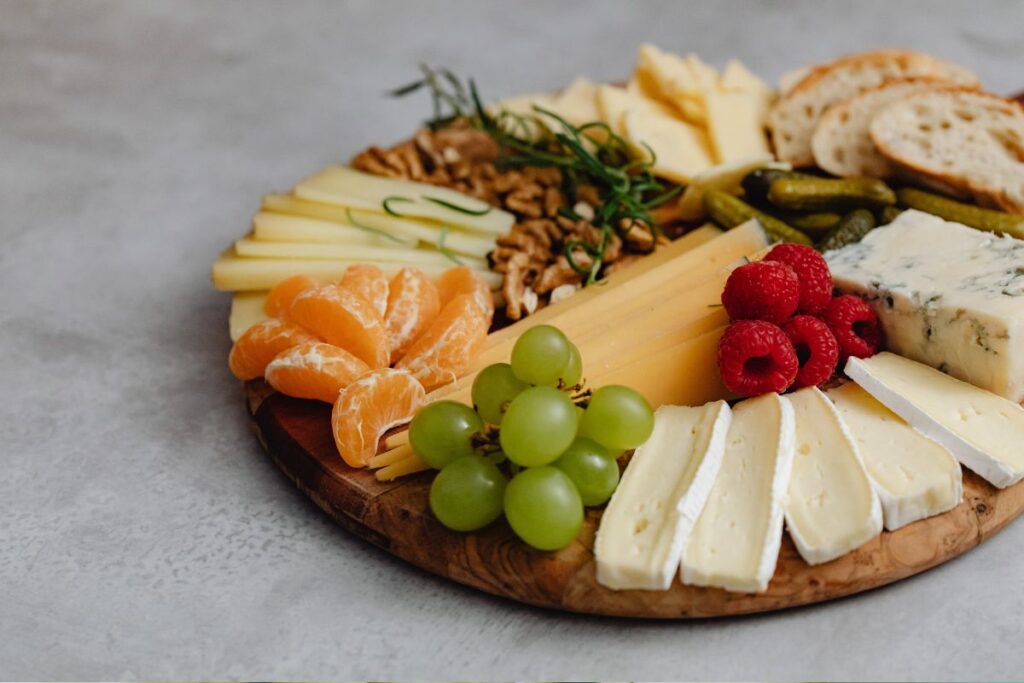
Why Choose a Wood Charcuterie Board
Wood has long been top choice as a surface to cut food on even since ancient times. While cutting boards, charcuterie boards, and serving trays come in various shapes, sizes, and materials like plastic, glass, steel, and marble, wood stands out for its knife-friendly nature, unlike other materials that can damage your cutting tools due to their hardness. Wood boards may accumulate knife marks, but with proper maintenance, they can self-repair, maintaining their overall apperance.
Wood Characteristics to Consider for the Best Wood for Charcuterie Boards
Choosing the perfect wood for a charcuterie board is a balance of aesthetics and practicality. It’s not merely about selecting an attractive piece of timber; it’s about ensuring that the wood can withstand the rigors of serving while highlighting your delectable offerings.
Here’s what to consider when choosing the best wood for charcuterie boards:
- Non-porous Wood: Prevents the growth of bacteria and simplifies cleaning. Porous wood will also stain easily
- Durability: Withstands knife marks and maintains its integrity over time.
- Uniform Grain: Provides a seamless surface for arranging food items.
- Visual Allure: Rich hues and textures elevate the presentation.
- Neutral Flavor: Preserves the authentic taste of cheeses and cured meats. In essence, the ideal wood for a top-notch charcuterie board harmonizes functionality with elegance, setting the scene for a truly delightful culinary affair.
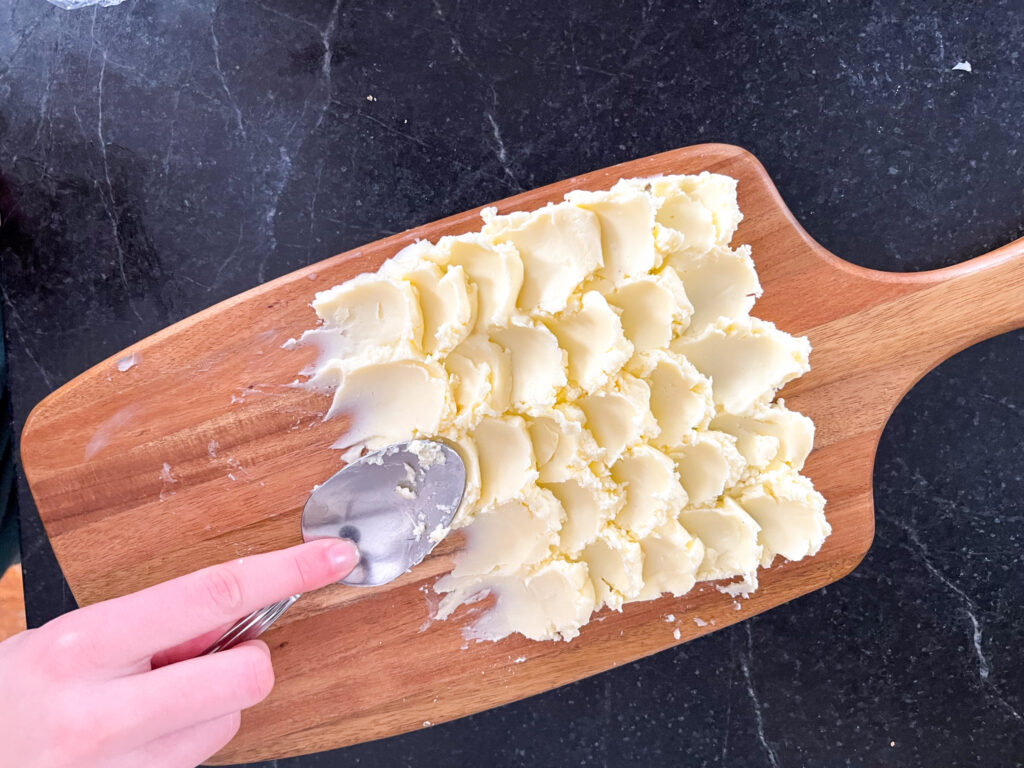
Softwood Or Hardwood Cutting Boards?
Choosing the best wood for charcuterie boards is important for preserving your tools and maintaining kitchen hygiene.
Hardwood, superior to softwood due to its durability and resistance to indentation, scratching, and mold, is the preferred choice for cooking. Hardwoods like maple, walnut, cherry, beech, and ash, with their close-grain structure and antibacterial properties, are excellent options for cutting boards. Beech, in particular, strikes a balance between hardness and knife-friendliness, making it a cost-effective choice for chopping and charcuterie boards.
Softwood will quickly show knife marks and are much harder to maintain over time.
End Grain vs. Edge Grain
Wood charcuterie boards are either made from the edge or end grain of the wood. These different surfaces of the wood each offer beautiful but different design options.
End Grain: end grain boards are often made from scrap wood generated from woodworking, which involve bringing the ends of wood pieces together with specific adhesives. This process not only enhances the wood’s natural beauty but also increases the boards’ resistance to cuts and warping. These boards are much harder to make but the end product is often worthe the effort. While end-grain boards are pricier, their designs make them highly sought after.
Edge grain chopping boards, with wood cut lengthwise, are more common due to their simpler design and affordability. With proper care, both types of boards can be excellent kitchen companions.
Finishing a Wooden Charcuterie Board
Almost as important as choosing the best wood for charcuterie boards is to decide how you will finish your board to help preserve the wood.
After you’ve made your board and sanded it, you will want to completely wipe off any dust and allow the board to dry completely. Next, I would apply a food-safe finish such as mineral oil or a blend of mineral oil and beeswax, using a clean cloth or brush to evenly coat the entire surface of the board. The finish should be applied liberally and allowed to penetrate the wood for several hours or overnight, ensuring thorough absorption. After the initial application, I would wipe away any excess finish with a clean cloth and allow the board to dry completely before buffing it to a smooth, lustrous finish. Repeat repeat the application process several times, allowing the finish to fully cure between coats, to ensure maximum protection and durability for the charcuterie board.
Below are some popular choice for the best charcuterie board finish:
- Mineral Oil: Mineral oil is a popular choice for finishing cutting boards because it is odorless, tasteless, and food-safe. It helps to moisturize and protect the wood, preventing it from drying out and cracking.
- Beeswax: Beeswax is often combined with mineral oil to create a protective and nourishing finish for cutting boards. It adds a subtle sheen to the wood and helps to seal and waterproof the surface.
- Walnut Oil: Walnut oil is a natural oil that is safe for food contact and can be used to finish cutting boards. It penetrates the wood to provide long-lasting protection and enhances the natural color and grain of the wood.
- Food-Grade Tung Oil: Tung oil is derived from the seeds of the tung tree and is commonly used as a finish for cutting boards. Look for food-grade tung oil, which is safe for use on surfaces that come into contact with food. This is my preferred type of finish for my boards.
- Butcher Block Conditioner: Butcher block conditioner is a combination of mineral oil and beeswax specifically formulated for treating wooden cutting boards, butcher blocks, and other food preparation surfaces. It provides a protective barrier against moisture and helps to maintain the beauty of the wood. No matter what finish I use, I usually keep butcher block conditioner on hand to use as a touch up.
- Carnauba Wax: Carnauba wax is a natural wax derived from the leaves of the carnauba palm tree. It can be mixed with mineral oil or applied on its own to create a durable and water-resistant finish for cutting boards.
- Shellac: Food-grade shellac, which is derived from the secretions of the lac bug, can also be used as a finish for cutting boards. It forms a hard, glossy coating that protects the wood from moisture and wear.
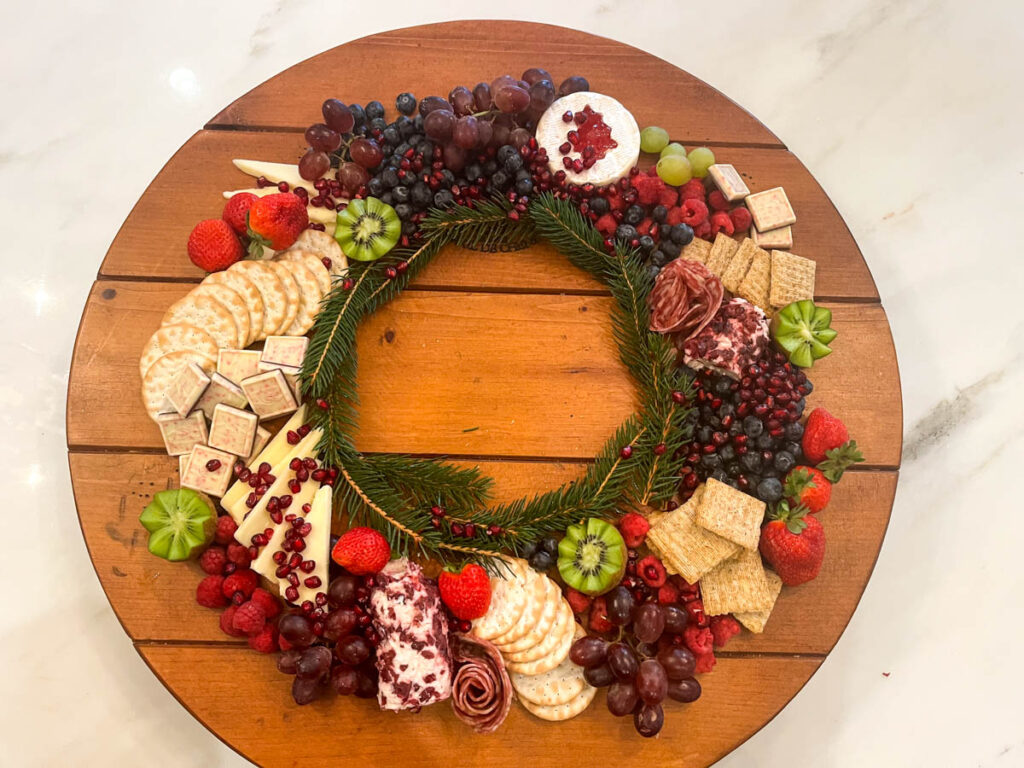
How to Clean a Wooden Cutting Board?
Despite wood’s susceptibility to cracking and warping, proper care can extend the lifespan of cutting boards. Avoid dishwashers, as the heat and water can damage wood. Instead, wash with mild soap and warm water, scrubbing thoroughly. After washing, air-dry the board standing up. For stains or odors, use vinegar or lemon juice. Regular oiling with food-safe mineral oil helps maintain the board’s integrity and prevents moisture penetration.
Avoid natural oils like vegetable or olive oil, which can turn rancid and cause odors. With appropriate maintenance, wooden boards can last a lifetime, making them excellent gifts for any occasion. Consider purchasing locally made wood boards, supporting artisans, and sharing food with loved ones during the holiday season.
You can follow along for more charcuterie board ideas with us on Pinterest.

